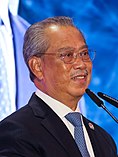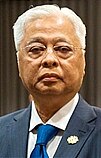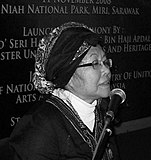University of Malaya
 | |
Former name | King Edward VII College of Medicine Raffles College University of Malaya in Singapore |
|---|---|
| Motto | Ilmu Puncha Kemajuan (Malay) |
Motto in English | Knowledge is the Source of Progress |
| Type | Public research university |
| Established | 28 September 1905[1][2] |
| Endowment | MYR633 million (2021)[3] (US$135 million) |
| Chancellor | Sultan Nazrin Muizzuddin Shah ibni Almarhum Sultan Azlan Muhibbuddin Shah (Sultan of Perak) |
| Vice-Chancellor | Prof. Dato' Seri Dr. Noor Azuan Abu Osman |
| Pro-Chancellors | Toh Puan Dato' Seri Dr. Hajah Aishah Ong Tan Sri Datuk Zainun Ali Tan Sri Dato' Seri Diraja Ramli Ngah Talib |
| Students | 36,444 (September 2024)[4] |
| Undergraduates | 19,134 (September 2024)[4] |
| Postgraduates | 17,310 (September 2024)[4] |
| Address | Universiti Malaya, 50603 , , 3°07′15″N 101°39′23″E / 3.12083°N 101.65639°E |
| Colours | Red, gold and blue |
| Affiliations | ACU, APRU, ASAIHL, AUN, FUIW,[5] APUCEN, UAiTED |
| Website | www |
The Universiti Malaya (lit 'University of Malaya'; abbreviated UM) is a public research university located in Kuala Lumpur, Malaysia. It is the oldest and highest ranking Malaysian institution of higher education,[6][7] and was the only university in newly independent Malaya.[8] The university has graduated five prime ministers of Malaysia, and other political, business, and cultural figures of national prominence.
The predecessor of the university, King Edward VII College of Medicine, was established on 28 September 1905 in Singapore, then a territory of the British Empire. In October 1949, the merger of the King Edward VII College of Medicine and Raffles College created the university. Rapid growth during its first decade caused the university to organize as two autonomous divisions on 15 January 1959, one located in Singapore and the other in Kuala Lumpur. In 1960, the governments of Malaya and Singapore indicated that these two divisions should become autonomous and separate national universities. One branch was located in Singapore, becoming the University of Singapore (merging into the National University of Singapore in 1980) after the independence of Singapore from Malaysia, and the other branch was located in Kuala Lumpur, retaining the name Universiti Malaya. Legislation was passed in 1961 and the Universiti Malaya was established on 1 January 1962.[1][9][10][2] In 2012, UM was granted autonomy by the Ministry of Higher Education.[11] The university also collaborated with the University of Wales in 2013 to establish International University of Malaya-Wales (IUMW), a private university in Malaysia.
Today, UM has more than 2,300 faculty members[4] and is divided into fourteen faculties, two academies, three institutes and two academic centres. In the latest QS World University Rankings, UM is currently ranked 60th in the world, 11th in Asia, 3rd in Southeast Asia and the highest ranked learning institution in Malaysia.[7]
History
[edit]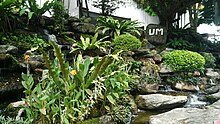
King Edward VII College of Medicine
[edit]The establishment of the university began with the issue of shortage of medical assistants in Singapore and Penang during the late 1890s.[12]: 1–2 The problem was addressed in a report published by the Education Commission in April 1902. In the report, it was stated that the commission was in favour of establishing a medical school to fulfil the demand for medical assistants in government hospitals. However, such a view was not in favour among the European community.[12]: 3–4
Legislation was passed by the Straits Legislative Council in June 1905 under Ordinance No. XV 1905. The school opened on 3 July 1905 and began functioning in September. On 28 September 1905, Sir John Anderson officiated the school under the name 'The Straits and Federated Malay States Government Medical School.'[12]: 6
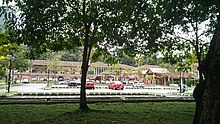
The school was located in the old Female Lunatic Asylum near the Singapore General Hospital at Sepoy Lines off New Bridge Road, where four of the asylum buildings were converted into a medical school. In 1907, a lecture hall and laboratory were added. There were no library and room to keep pathological specimens.[12]: 6
In 1905, there were 17 medical students, four students attending the hospital assistant course. Five years later, the enrolments increased to 90 medical students and 30 trainee hospital assistants. The school had only one permanent staff which was the Principal, the teaching staff were employed on a part-time basis. The Principal was Dr Gerald Dudley Freer, who previously served as Senior Colonial Surgeon Resident of Penang.[12]: 6–9 [13]
The School Council wanted to gain recognition of its Diploma by the General Council of Medical Education in the United Kingdom to ensure that the Licentiate of Medicine and Surgery Diploma offered by the school would gain worldwide recognition. In 1916, the GCME recognised the Licentiate of Medicine and Surgery Diploma offered by the school. The licentiates were placed on the General Council's Colonial List of the British Medical Register and were entitled to practise anywhere within the British Empire.[12]: 10

In 1910, Dr Robert Donald Keith became the second Principal of the School. The first two years of the five-year course were devoted to pure science studies. Physics, biology and chemistry were taught in the first year, followed by physiology and elementary anatomy in the second year. The remaining three years were attachment to clinical clerkships in medicine, surgery and midwifery, which covered pathology, hygiene and medical jurisprudence. Materia Medica was integrated into the fourth year, where practical pharmacy was taught.[12]: 7
Students were posted to several hospitals, initially at the Singapore General Hospital. From 1908 onwards, attachments were made to Tan Tock Seng Hospital (for medicine and surgery) and Kandang Kerbau Maternity Hospital (for midwifery).[12]: 7

In 1912, the medical school received an endowment of $120,000 from the King Edward VII Memorial Fund, started by Dr Lim Boon Keng. Subsequently, on 18 November 1913, the name of the school was changed to the King Edward VII School of Medicine.[12]: 11–12
In the first batch of 16 students of 1905, only seven made to the final and graduated in May 1910 while the remaining six students graduated in four months later and others resigned from the school. In 1919, the drop-out rate had risen to 35%, while in 1939 the number of students failed in their final examinations stood at 44%.[12]: 10
At this time a hostel was built to accommodate 72 male students from the Federated Malay States.
In 1921, the school was elevated in status to college. Between 1920 and 1930, the college went through a series of transformations, by replacing the old teaching staff with a younger generation of professionals and also nine new Chairs were created, the first in Anatomy in 1920, followed by Medicine, Surgery, and Midwifery & Gynaecology in 1922 and Clinical Surgery, Bacteriology, Biology, Bio-Chemistry, and Dental Surgery in 1926. And the tenth chair for Pathology was created in 1935.[12]: 12–14
In 1923, the college's new building at Outram Road was commenced. It was completed in November 1925 and officially opened by Sir Laurence Guillemard in February 1926. During the opening ceremony, the college conferred Honorary Diplomas on Sir David James Galloway, Dr Malcolm Watson and Dr Lim Boon Keng.[12]: 14
In 1929, Dr George V. Allen the new principal took the helm, succeeding his predecessor Dr MacAlister.
Raffles College
[edit]The establishment of Raffles College was a brainchild of Sir Stamford Raffles and Dr Robert Morison. Sir Stamford had some knowledge of the Malay language and culture, while Morison was a distinguished sinologist missionary. Both men wanted to establish a centre dedicating to the study of Malays and Chinese at tertiary level.[12]: 23
On 5 June 1823, a site designated for an education institution had its foundation stone laid by Sir Stamford. Soon after that, Raffles left for England and Morrison left for China, thus the establishment of the school never happened. The school building was revived as an English school named the Raffles Institution.[12]: 23
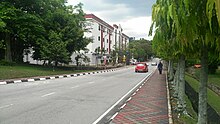
In 1918, Sir William George Maxwell, the Colonial Secretary of the Straits Settlements chaired the Maxwell Committee to review the scheme to commemorate the centenary of the founding of Singapore by Sir Stamford. The committee members were Roland Braddell, A.W. Still, Seah Ling Seah, Dr Lim Boon Keng, Mohammed Yusoff bin Mohammed, N.V. Samy, and Mannesseh Meyer. The working committee headed by H.W. Firmstone recommended the establishment of a college for tertiary education to commemorate the centenary founding of Singapore.[12]: 25 On 12 July 1919, the Government decided to undertake the construction of the building with the cost not more than $1,000,000 and would contribute $50,000 as annual recurrent expenditure as soon as the Centenary Committee had collected $2,000,000 for the Raffles College Endowment Fund. On 31 August 1920, the committee had achieved the figure, amounting to $2,391,040.[12]: 26 On 31 May 1920, Richard Olaf Winstedt was appointed as the Acting Principal of Raffles College. The course offered was a three-year basis. The establishment of the school was seen far more systematic compared to the King Edward VII Medical College. The school was situated at a site called the Economic Gardens and was designed by Cyril Farey and Graham Dawbarn. And the construction took place in 1926.[12]: 27
Following completion of the first hostel, Raffles College was opened informally to students on 12 June 1928.[14] Of the first 43 students, nine were private students, and the rest were government-funded; there were two women among this first cohort.[14] On 22 July 1929, Raffles College was formally established. Its students studied either arts or sciences, and graduated with a diploma after three years.[15] Science students were permitted to use the labs of the King Edward VII College.[14] Four years later, the College Council proposed changes in the curriculum, so that the Diploma could be furthered to a Degree through external examinations in collaboration with universities in England.
In 1937, Sir Shenton Thomas declared the college would have a full-time Principal. The college had its fourth Principal, Alexander Keir, succeeding Frederick Joseph Morten. By 1939 war was waged in Europe, and had put a halt to the development of the college. The war in Europe came to Asia and Singapore was invaded by the Japanese in February 1942.
After the war, the school was reopened and W.E. Dyer was Principal. The future of Raffles College was uncertain, until 1948 when Dr George V. Allen (later Sir) who was formerly the Principal of King Edward VII Medical College posted as the last Principal of Raffles College. The college was amalgamated with the former, for the making of a university for the Malayans.
Universiti Malaya (1949–1962)
[edit]
In 1938, the government appointed a commission under the chairmanship of Sir William McLean to study the higher education potential and progress in Malaya. The Commission concluded that Malaya was not ready to have a university, and that a university college would be more suitable.
In 1943, Oliver Stanley, the Secretary of State for the Colonies, appointed a commission of inquiry chaired by Cyril Asquith to consider the development of higher education in the colonies across the British Empire.[16] The Asquith Commission, reporting in 1945, endorsed the McLean Commission's recommendations for Malaya.[17]
In 1946, Raymond Priestley, the Vice-Chancellor of Birmingham University and member of the previous Asquith Commission, was invited by the British Malaya Government to visit and discuss the application of the Asquith Commission's recommendations to Singapore and Malaya.[18][19] Priestley again recommended the establishment of a university college as a first step.[20][21][22]
In January 1947, the Secretary of State for the Colonies, now Arthur Creech Jones, appointed Sir Alexander Carr-Saunders to chair a commission determining the details of establishing a university college in Malaya.[23] In March of the same year, the other members of the commission were announced and George Allen, principal of King George VII College, was appointed principal-designate of the planned university college.[24][25] Carr-Saunders listened to the thoughts of the alumni association and students' union of King Edward VII College; he was impressed with the ideas of the president of the students' union, Kanagaratnam Shanmugaratnam.[26][27][28] In 1948, the Carr-Saunders Commission recommended the immediate establishment of a full university, bypassing the intermediate step of a university college recommended by previous commissions.[29]

As a result, the institution named the Universiti Malaya was chartered under the Carr-Saunders Commission in 1949. The formation of the Universiti Malaya on 8 October 1949 in Bukit Timah Campus (Former site of Raffles College), Singapore came from the merger of King Edward VII College of Medicine and Raffles College, which had been established in 1905 and 1929, respectively.[30]
In Carr-Saunders Commission's report in 1949, it was stated that "the university shall act as a single medium of mingle for enhancing the understanding among the multi-ethnics and religions in the back than Malaya. The University too should be modelled after the tertiary educations in the United Kingdom of Great Britain in term of academic system and administration structure".
The Carr-Saunders Commission postulates "the principle that all children who show the necessary capacity should enjoy an equal chance of reaching the University; and, in particular, that no able child should be handicapped in climbing the educational ladder by race, religion, rural domicile, or lack of means."
In 1959, the university was divided into two autonomous campuses, one in Singapore, known as University of Malaya in Singapore, and the other in Kuala Lumpur (Universiti Malaya in Kuala Lumpur).
Universiti Malaya (re-established 1962)
[edit]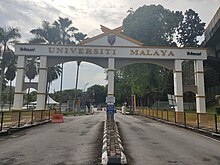
In 1961, the governments of Malaysia and Singapore passed laws to split the Universiti Malaya into two national universities. As a result, on 1 January 1962, the Universiti Malaya was re-established on the 309 hectare campus in Kuala Lumpur, retaining its original name and became the only university in the post-independent Malaya.[8] The Bukit Timah campus in Singapore became the University of Singapore (today the National University of Singapore).
On 16 June 1962, the newly independent university in Kuala Lumpur celebrated the installation of its first Chancellor, Tunku Abdul Rahman, Malaysia's first Prime Minister. The first Vice-Chancellor was former Dean of Arts, Sir Alexander Oppenheim, the mathematician who formulated the Oppenheim conjecture in 1929.[31] When Oppenheim left in 1965 with no successor in sight, Rayson Huang who later became the Vice Chancellor of Nanyang University, Singapore in 1969 and in 1972 went on to become the first Asian Vice-Chancellor of the University of Hong Kong,[32] was asked to take over as the Acting Vice-Chancellor. He served in that capacity for 12 months but declined reappointment to return to academic pursuits.[33]
Chin Fung Kee, an authority in geotechnical engineering,[34] replaced Huang as Acting Vice-Chancellor until the university filling the position in 1967 by the appointment of James H.E. Griffiths. A distinguished physicist and a fellow of Magdalen College, Oxford, Griffiths was also the former head of Clarendon Laboratory of Oxford University and one of the discoverers of ferromagnetic resonance.
UM remained Malaysia's primary public university until 1 June 1969, when the nation's second public university – Universiti Sains Malaysia was established in Gelugor on Penang Island.[35]
On 1 March 1997, UM became the first university in Malaysia to be corporatised, in a move intended by the Federal Government to decentralise and transform public universities to become more effective and competitive.[36]
Coat of arms
[edit]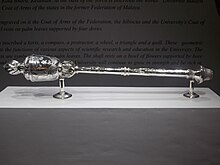
The UM's coat of arms was designed under a council established in 1961, chaired by Tan Sri Y.C. Foo. The members of the committee involved in the design were the chairman of the council, Y.C. Foo, Professor A. Oppenheim (the vice-chancellor) and Professor Ungku Aziz (later regius professor). The coat of arms was officially chartered in April 1962 by Tunku Abdul Rahman, the university's first chancellor.[12]: ii
The coat of arms is divided into two parts, namely the chief (upper part) and the base (the remainder). The chief is a bundle of seventeen strips of the leaves of Borassus flabellifer or the Palmrya palm. These strips were used as printed material for ancient books by the Malays, long before paper was invented. On the centre of these seventeen strips is the university's motto 'Ilmu Puncha Kemajuan'. The motto consists of 'Ilmu' derived from Arabic, 'Puncha' from Sanskrit (Za'aba Spelling for 'Punca'), and 'Kemajuan' from Malay. These words mean knowledge is the source of progress.[12]: ii
In the centre of the arms is a Bunga Raya or hibiscus rosa-sinensis species encircled by three Malayan tigers. The tigers symbolise the three main races in Malaysia (Malays, Chinese and Indians), who work hand-in-hand to protect the nation and uphold the duty to serve the country.[12]: ii It is blazoned:
Azure, fimbriated and parted per fess by a line Or. In base a Bunga Raya or hibiscus flower between three tigers passant regardant two and one all proper; and in Chief a bundle of seventeen strips of the leaves of Palmyra Palm or borassus flabellifer Or inscribed with the words 'ILMU PUNCHA KEMAJUAN'.

Since the late 1990s, the UM coat of arms was accompanied by the university's wordmark which is written in capital letters – 'UNIVERSITI MALAYA' in Malay or 'UNIVERSITY OF MALAYA' in English as seen on its corporate logo. This made UM the only university in Malaysia to have a different language versions of its logo. But in late 2019, the university have decided to only use its logo with its official name in Malay language and thus, the English version of its logo is no longer used. The reason given by the university for the change was to make its official Malay name easier to pronounce. In 2022, UM made a refreshment on its corporate logo where the university's wordmark is shown to be thinner instead and the red colour in the 'U' and 'M' letters were removed while its coat of arms remains unchanged. However, the university's previous logo would continued to be used for non-academic and non-corporate purposes.
UM is currently one of the three public universities in Malaysia to adopt its coat of arms, the other two are University of Science Malaysia (USM) and the National University of Malaysia.
Academic profile
[edit]| University rankings | |
|---|---|
| Global – Overall | |
| ARWU World[37] | 401–500 (2024) |
| CWTS World[38] | 293 (2024) |
| QS World[39] | 60 (2025) |
| THE World[40] | 251–300 (2025) |
| USNWR Global[41] | 281 (2024) |
| Regional – Overall | |
| QS Asia[42] | 11 (2024) |
| THE Asia[43] | 65 (2024) |
| USNWR Asia[44] | 60 (2024) |
| National – Overall | |
| QS National[45] | 1 (2024) |
UM has been ranked consistently as the No. 1 university in Malaysia and among the top 3 universities in Southeast Asia, as well as among the top 300 universities in the world according to reputed ranking publisher such as QS, ARWU, U.S. News & World Report in the recent few years. Currently UM is ranked 60th in the world in the QS World University Rankings 2025, 281th in the USNWR 2024 global rankings, 293rd in the 2024 CWTS Leiden Ranking, and among the top 300 universities in the Times Higher Education (THE) World University Rankings.
In 2015 it has been ranked 54th in Engineering & Technology in QS world ranking. UM rose to the top 100 universities in the QS World University Rankings 2019, and has consistently increased in ranking to 59th in the world and 9th in Asia in the 2021 series. In 2021, U.S. News & World Report ranked UM 17th and 87th in the world in Engineering and Computer Science respectively by its subject ranking.[46]
The business school of UM has achieved two international accreditations i.e. Association to Advance Collegiate Schools of Business (AACSB) and Association of MBAs (AMBA).
The Faculty of Languages and Linguistics, Japanese Language and Linguistic Course was awarded the Japanese Foreign Minister's Commendation for their contributions to promotion of Japanese language education in Malaysia on 1 December 2020.[47][48]
| Ranking | 2024 | 2023 | 2022 | 2021 | 2020 | 2019 | 2018 |
|---|---|---|---|---|---|---|---|
| Academic Ranking of World Universities | 401-500 | 401-450 | 301-400 | 301-400 | 301-400 | 301-400 | 301-400 |
| QS World University Rankings | 65 | 70 | 65 | 59 | 70 | 87 | 114 |
| Times Higher Education World University Rankings | 251-300 | 351-400 | 301-350 | 301-350 | 301-350 | 301-350 | 351-400 |
Transportation access
[edit]
The Universiti Malaya campus is accessible by car, bus, and both the LRT Kelana Jaya Line (Line 5), MRT Kajang Line (Line 9) and KTM Port Klang Line (Line 2) of the Klang Valley Integrated Transit System. The campus will also become accessible by future MRT Circle Line.


The campus can be accessed by alighting from KJ19 Universiti on LRT Kelana Jaya Line, with a 15-minute walk to the Kuala Lumpur (KL) entrance. KD02 Angkasapuri station on the Port Klang Komuter Line or KG12 Phileo Damansara MRT station are the other two nearest stations. The former has a connection to the GoKL Pink Line bus service, where the bus stops at the nearby mosque, which is about a 5 to 10-minute walk from the KL entrance. The latter is 3 km from the campus' Petaling Jaya (PJ) main entrance, supplemented by T815 MRT Feeder Bus service. Several bus routes operated by Rapid KL include T815 and T789, both of which connect to Phileo Damansara and Universiti stations respectively. PJ City Bus free ride service also has a stop in University Malaya Medical Centre (PPUM) and can be accessed from the PJ gate. Other rapidKL bus services may stop at PPUM. The proposed CC33 UM on MRT Circle Line is planned to be built inside the campus, near PPUM.
Signage showing the direction of buildings and other sites appears frequently next to the campus roadways.
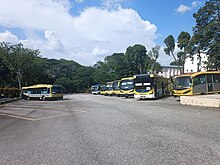
The university also provides complimentary shuttle bus services during weekdays for students with 5 different routes, named AB, BA, C, D and E. Certain routes serve areas within the campus, while others connect external accommodation or buildings with the main campus area.[49]
Organisation and administration
[edit]Vice-chancellors
[edit]
This is a list of vice-chancellors of the University of Malaya.[50]
| No. | Vice-Chancellor | Honour | Qualifications | Term in Office |
|---|---|---|---|---|
| Before Independence | Sir Dr. George V. Allen | CBE, Kt, LL.D. (Malaya, Belfast and Aberdeen), D.Sc. (Kent) | MD, MB, BCh, BAO (Belfast), DTM&H (Lond.) | 1949–1952 |
| Before Independence | Sir Dr. Sydney Caine | KCMG, LL.D. (Malaya) | BSc (LSE) | 1952–1956 |
| 1 | Professor Tan Sri Sir Dr. Alexander Oppenheim | OBE, PMN, KT, LL.D. (Malaya) | PhD (UC), D.Sc. (Oxon) | 1956–1965 |
| Acting | Dr. Rayson Huang Li Song | CBE, ORS, JP, D.Sc. (HKU) | D.Phil (Oxon), D.Sc. (Oxon), D.Sc. (Malaya), BSc (HKU) | 1965–1966 |
| Acting | Professor Emeritus Tan Sri Datuk Dr. Chin Fung Kee | JMN, PSM, DMPN, D.Sc. (Belfast, Singapore, and Glasgow) | MEng (Belfast), BEng (Civil) (Belfast), Dip. Arts (Raffles College) | 1966–1967 |
| 2 | Dr. James H.E. Griffiths | OBE | PhD (Oxon), MA (Oxon) | 1967–1968 |
| 3 | Regius Professor Dr. Ungku Abdul Aziz bin Ungku Abdul Hamid | Regius Professor (Malaya) | PhD (Waseda), Dip. Arts (Raffles College) | 1968–1988 |
| 4 | Professor Dato' Dr. Syed Hussein Alatas | DSPN | PhD (Amsterdam) | 1988–1991 |
| 5 | Professor Emeritus Datuk Dr. Mohd. Taib Osman | JSM | PhD (Indiana), MA (Malaya), BA (Malaya) | 1991–1994 |
| 6 | Tan Sri Dato' Dr. Abdullah Sanusi Ahmad | PSM, KMN, DSNS | PhD (USC), MA (Pitt) BA (Malaya) | 1994–2000 |
| 7 | Professor Dato' Dr. Anuar Zaini Md. Zain | DPMP | MBBS (Malaya) | 2000–2003 |
| 8 | Professor Emeritus Datuk Dr. Hashim Yaacob | DPSK, SPSK | MSc (Lond.), BDS (Otago) | 2003–2006 |
| 9 | Tan Sri Datuk Dr. Rafiah Salim | PSM, Hon. DUniv (Belfast) | LL.D. (Belfast), LL.M. (Belfast) | 2006–2008 |
| 10 | Tan Sri Datuk Dr. Ghauth Jasmon | PSM, DMSM | PhD (Lond.), BEng (Electrical) (Lond.) | 2008–2013 |
| 11 | Professor Tan Sri Dato' Dr. Mohd. Amin Jalaludin | PSM, DPMS | MBBS (Malaya), FRCS (Royal College of Surgeons of Edinburgh) | 2013–2017 |
| 12 | Datuk Ir. (Dr.) Abdul Rahim Hj. Hashim | PJN, D.Eng (Birmingham) | BEng (Birmingham) | 2017–2020 |
| 13 | Professor Dato' Ir. Dr. Mohd. Hamdi Abd. Shukor | DPNS | D.Eng (Kyoto), MSc (UMIST), BEng (Hons) (Mech) (Imperial) | 2020–2023 |
| 14 | Professor Dato' Seri Ir. Dr. Noor Azuan Abu Osman | DGPN | PhD (Strathclyde), MSc (Strathclyde), BEng (Hons) (Mech) (Bradford) | 2023–Present |
Notable alumni
[edit]Throughout the years, UM has produced many alumni that have contributed significantly towards the development of Malaysia, and its graduates have been notable in various fields within the country. In politics, UM has produced the highest number of prime ministers in the country where out of ten Malaysian prime ministers, five of them attended UM, with Mahathir Mohamad becoming the only prime minister to be elected twice. Numerous UM graduates have been elected as members of parliament to the Dewan Rakyat, senators to the Dewan Negara, members of the State Legislative Assembly, as well as being ministers of the federal cabinet, chief ministers, governors, and speakers to both houses of representatives. Notable politicians include current Speaker of the Dewan Rakyat Johari Abdul,[51] former President of the Dewan Negara Vigneswaran Sanasee,[52] former Minister of Finance Daim Zainuddin who finished his doctoral thesis at UM,[53] former Yang di-Pertua Negeri of Malacca and Menteri Besar of Pahang Mohd Khalil Yaakob,[54] and Member of Parliament for Sungai Buloh and Rhodes Scholar Sivarasa Rasiah.[55]
- Notable UM Alumni
-
Ungku Abdul Aziz, Malaysia's first Regius Professor
-
Wang Gungwu, Tang Prize laureate
-
Teh Hong Piow, billionaire and founder of Public Bank Berhad
-
Pandelela Rinong, two-time Olympic medalist
-
Faiz Khaleed, Malaysian astronaut candidate
UM has also produced a large number of lawyers, diplomats and public servants that have hold top posts within their respective fields. In diplomacy and foreign affairs, 51st President of the United Nations General Assembly Razali Ismail,[56] and 8th Secretary General of the ASEAN Ajit Singh,[57] both studied at UM for their undergraduate degrees. More than half of the Chief Secretary to the Government of Malaysia has been a graduate from UM where out of fifteen of them, eight has studied at UM, where Ismail Bakar is the most recent alumnus to hold the post.[58] Two former Inspector-General of the Royal Malaysian Police Norian Mai and Mohamad Fuzi Harun[59] also attended UM. In law, two Chief Justice of Malaysia, three President of the Court of Appeal of Malaysia, three Attorney General of Malaysia, three Chief Judge of Malaya and one Chief Judge of Sabah and Sarawak have all attended UM Law School.
Four governors of the Malaysian central bank, Bank Negara Malaysia, Ali Abul Hassan bin Sulaiman,[60] Zeti Akhtar Aziz,[61] Muhammad bin Ibrahim,[62] and Shaik Abdul Rasheed Abdul Ghaffour all studied commerce at UM.[63] Business people include billionaires such as the founder and chairman of Top Glove Corporation Bhd, Lim Wee-Chai,[64] CEO of Westports Holdings G. Gnanalingam,[65] founder and chairman of Public Bank Berhad Teh Hong Piow,[66] and founder of NagaCorp Ltd Chen Lip Keong.[67]
Various corporate figures such as the former chairman, president and CEO of Petronas Azizan Zainul Abidin,[68] president and CEO of Maybank Amirsham Abdul Aziz,[69] co-founder of AirAsia Pahamin Rajab,[70] and former CEO of Permodalan Nasional Berhad Khalid Ibrahim.[71]
Two of Malaysia's only regius professors Ungku Aziz and Syed Muhammad Naquib al-Attas have been affiliated with UM during the early years of the university. All four out of five distinguished professors in Malaysia which include Shamsul Amri Baharuddin, Mohd Kamal Hassan, Harith Ahmad, and Looi Lai Meng have all studied at the university with the exception of Rajah Rasiah who is currently affiliated with UM.
In literature and the arts, five Malaysian National Laureates have studied in UM which include writer and Tokoh Akademi Negara Muhammad Haji Salleh,[72] novelists Anwar Ridhwan[73] and Siti Zainon Ismail,[74] writer Baha Zain[75] and the first female recipient of the award, Zurinah Hassan.[76] Moreover, various UM alumnus have won the Southeast Asian Writers Award, including novelist Malim Ghozali PK[77] and author Adibah Amin.[78]
Student life
[edit]Student bodies
[edit]The UM's campus student bodies, known as Universiti Malaya Students' Union (UMSU) are elected by the students to have representatives engaging in policies and matters relating to student affairs. As such the elections, known as 'PRKUM' which is acronym for Pilihanraya Kampus Universiti Malaya in Malay language is seen as a precursor to a student leader.[79] Whilst prior elections before 2019 was organised by the Student Affairs Department of the university, the first election managed by the students[80] was conducted on 4 March 2019, marking a historic first whereby an all student affair made the elections a milestone. Suara Siswa, a pro-student group won the elections which saw 61% of 13,671 students cast their votes.[81] UM also has its own radio station, UMalaya Radio which is under the auspices of its Student & Alumni Affairs Division.
Facilities
[edit]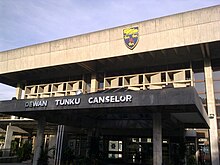

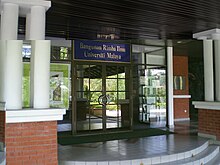
The university houses 13 residential colleges (11 in-campus, 2 off-campus), an Olympic-sized swimming pool, the Rimba Ilmu Botanical Gardens, the UM Arena which boasts a full course running track, several museums of different fields as well as numerous sports facilities (gymnasiums, courts and fields) in the campus. The university's teaching hospital, Universiti Malaya Medical Centre (UMMC) is located at the boundaries of UM near the Petaling Jaya gate.
Residential colleges
[edit]Unlike other global universities, colleges in UM does not function as accommodation and institution. They are only functioned as hostels for students.
During the pandemic, all colleges were at limited capacity or closed. In September 2021, they were in the process of being reopened in conjunction with the loosening of pandemic measures by the government.[82] Many colleges have their own basic facilities, such as a restaurant. In the 12th college (UM labels their residential colleges by name and dedicated number) lies a well known hipster cafe called He and She Coffee.[83]
- Tuanku Abdul Rahman Residential College
- Tuanku Bahiyah Residential College
- Tuanku Kurshiah Residential College
- Bestari Residential College
- Dayasari Residential College
- Ibnu Sina Residential College (Clinical & Health Profession Students Hostel: Medicine, Nursing, Dental, Biomedic, Pharmacy)
- Za'ba Residential College
- Kinabalu Residential College
- Tun Syed Zahiruddin Residential College (off-campus limits)
- Tun Ahmad Zaidi Residential College
- Ungku Aziz Residential College
- Raja Dr. Nazrin Shah Residential College
- 13th Residential College (Formerly International Islamic University of Malaysia Petaling Jaya foundation campus)
Dewan Tunku Canselor (Tunku Chancellor Hall)[edit]The Dewan Tunku Canselor, also popularly known as DTC, is one of the 47 buildings listed under the National Heritage list, as well as a UNESCO Heritage Building. The building was named and officiated by the first prime minister of Malaysia, Tunku Abdul Rahman on 25 June 1966 where he became the university's chancellor at that time. It was designed by Dato' Kington Loo/CHR Bailey, an architect from the firm BEP Arkitek. Panggung Eksperimen (Experimental Theatre)[edit]The UMMC formerly known as University Hospital, is a government-funded medical institution located in Pantai Dalam, southwest corner of Kuala Lumpur, Malaysia. It was established by Statute in September 1962 and is part of Universiti Malaya.[citation needed] Museums and galleries[edit]
|
Libraries[edit]Central Library[edit]
Branch libraries[edit]
Special libraries[edit]
|
In the media
[edit]UM became a subject matter in the 1987 documentary film, Dari Desa Ke Kampus (lit. From the Countryside to the Campus), produced by Filem Negara Malaysia.[84]
See also
[edit]- The National University of Malaysia
- List of Islamic educational institutions
- Universiti Malaya Medical Centre
- UM Specialist Centre
- Faculty of Medicine, Universiti Malaya
- Centre for Foundation Studies, Universiti Malaya
- UM Botanical Gardens Rimba Ilmu
- National University of Singapore
- International University of Malaya-Wales
References
[edit]Citations
[edit]- ^ a b "Our History". um.edu.my. Archived from the original on 8 September 2017. Retrieved 25 September 2017.
- ^ a b "University of Malaya – The oldest university in Malaysia". Malaysia Central. 6 June 2008. Retrieved 25 September 2017.
- ^ "Financial Report 2021" (PDF). Universiti Malaya. 2021. p. 339.
- ^ a b c d "UM Fact Sheet". um.edu.my. Archived from the original on 18 April 2018.
- ^ "Federation of the Universities of the Islamic World". Archived from the original on 26 January 2005. Retrieved 16 April 2010.
- ^ "World University Rankings". Times Higher Education (THE). 26 September 2018. Retrieved 11 May 2019.
- ^ a b "Universiti Malaya (UM)". QS Top Universities. Retrieved 31 July 2018.
- ^ a b "Learning from Universiti Malaya's success stories". The New Straits Times. 8 November 2021. Retrieved 4 May 2022.
- ^ humans.txt. "UM Fact Sheet". um.edu.my. Retrieved 23 July 2018.
- ^ "Our Chancellors and Vice-Chancellors : A biographical sketch : NUS History". Archived from the original on 20 June 2016. Retrieved 18 April 2017.
- ^ AMINUDDIN, MOHSIN. "UM set for autonomy". The Star. Archived from the original on 26 January 2012. Retrieved 10 February 2012.
- ^ a b c d e f g h i j k l m n o p q r s t Khoo, Kay Kim (2005). 100 Years: The University of Malaya. Kuala Lumpur, Malaysia: University of Malaya Press. ISBN 983-100-323-3.
- ^ Cheah, Jin Seng; TM Ho; BY Ng (July 2005). "The First Graduates in 1910". Annals Academy of Medicine (PDF). 6. Vol. 34. Singapore: National University of Singapore. pp. 19C.
- ^ a b c "Raffles College: Progress of Building Operations – Forty-three Students". Singapore Free Press and Mercantile Advertiser. 5 July 1928. p. 9 – via NewspaperSG.
- ^ Ling, Guay Ee; Tang, Joanna H. S. (2016). "Raffles College". Singapore Infopedia. National Library Board. Retrieved 12 May 2022.
- ^ "Colonial Affairs". Parliamentary Debates (Hansard). United Kingdom: House of Commons. 13 July 1943. col. 51. Retrieved 28 April 2022.
- ^ Colonial Office (June 1945). Report of the Commission on Higher Education in the Colonies. London: HM Stationery Office. Cmd. 6647. Retrieved 27 April 2022 – via Library of Congress of Chile.
- ^ "New Talks About University". Straits Budget. Singapore. 5 September 1946. p. 7. Retrieved 28 April 2022 – via NewspaperSG.
- ^ "Higher Education: Report Tomorrow". Morning Tribune. Singapore. 12 September 1946. p. 2. Retrieved 28 April 2022 – via NewspaperSG.
- ^ "University College for Malaya". Singapore Free Press. 14 September 1946. p. 5. Retrieved 28 April 2022 – via NewspaperSG.
- ^ "Raffles to Be University College?: Dr Priestley's Warning to Move 'Fairly Fast'". The Straits Times. Singapore. 14 September 1946. p. 5. Retrieved 28 April 2022 – via NewspaperSG.
- ^ "Degrees Instead of Diplomas". The Straits Times. Singapore. 16 September 1946. p. 4. Retrieved 28 April 2022 – via NewspaperSG.
- ^ "Higher Education". Parliamentary Debates (Hansard). United Kingdom: House of Commons. 29 January 1947. Retrieved 26 April 2022.
- ^ "Dr Allen to Head New College". The Straits Times. Singapore. 15 March 1947. p. 1. Retrieved 28 April 2022 – via NewspaperSG.
- ^ "Higher Education Commission to Plan University College of Malaya". Indian Daily Mail. Singapore. 17 March 1947. p. 4. Retrieved 28 April 2022 – via NewspaperSG.
- ^ Low, S. W.; Gan, W. T.; Tan (2005). "A Century of Medical Students' Activities (Medical College Union/Medical Society)". Annals of the Academy of Medicine, Singapore. 34 (6): 152C – 154C. doi:10.47102/annals-acadmedsg.V34N6p152C. PMID 16010398. Retrieved 28 April 2022.
- ^ "Remembering Emeritus Professor K. Shanmugaratnam". NUS Yong Loo Lin School of Medicine. National University of Singapore. 30 July 2018. Retrieved 28 April 2022.
- ^ Ng Keng Gene; Zaccheus, Melody (30 July 2018). "Founder of Singapore Cancer Registry K. Shanmugaratnam dies aged 97". The Straits Times. Singapore. Retrieved 28 April 2022.
- ^ "Malaya". Parliamentary Debates (Hansard). United Kingdom: House of Lords. 10 November 1948. Retrieved 26 April 2022.
- ^ Federation of Malaya: Annual Report 1957 (Report). The Stationery Office. p. 258. Retrieved 27 November 2024.
- ^ Greenfield, Richard (15 December 1997). "Obituary: Sir Alexander Oppenheim". The Independent. Retrieved 11 March 2021.
- ^ University of Hong Kong: A Lifetime of Memories – Dr Rayson Huang Book Launch (retrieved 11 June 2008)
- ^ Huang, Rayson (2000). "A New University in a New Country". A Lifetime in Academia: An Autobiography by Rayson Huang. Hong Kong, China: Hong Kong University Press. pp. 81–83. ISBN 962-209-518-6.
- ^ Southeast Asian Geotechnical Society: A Brief History of the SEAGS Archived 20 April 2008 at the Wayback Machine
- ^ Chang Da Wan. "The History of University Autonomy in Malaysia" (PDF). Institute For Democracy and Economic Affairs.
- ^ Hanizah Hashim (8 October 1999). "Commitment to produce high achievers". New Straits Times.
- ^ Academic Ranking of World Universities 2024
- ^ CWTS World University Rankings 2024
- ^ QS World University Rankings 2025
- ^ THE World University Rankings 2025
- ^ "2024-2025 Best Global Universities Rankings".
- ^ QS Asia University Rankings 2024
- ^ THE Asia University Rankings 2024
- ^ "2024-2025 Best Global Universities in Asia".
- ^ QS Malaysian University Rankings 2024
- ^ "US News Ranking".
- ^ Foreign Minister's Commendations for FY 2020 | Ministry of Foreign Affairs of Japan
- ^ Foreign Minister's Commendations for FY 2020 (Groups) | Ministry of Foreign Affairs of Japan
- ^ "Transport". Department of Development & Estate Maintenance UM. 20 September 2021. Retrieved 14 May 2022.
- ^ "Former Vice-Chancellors". University of Malaya.
- ^ "Johari Abdul: Dari kerusi Parlimen ke Yang Dipertua". Berita Harian (in Malay). 19 December 2022. Retrieved 26 October 2023.
- ^ "PROMULGATION OF THE 17TH PRESIDENT OF THE SENATE". Malaysian Parliament. 11 May 2016. Retrieved 26 October 2023.
- ^ "Daim gets PhD 11 years later". New Straits Times. 13 October 2019. Retrieved 26 October 2023.
- ^ "Tun Datuk Seri Utama Dr. Mohd Khalil Bin Yaakob". Klip.my. Retrieved 26 October 2023.
- ^ "Sivarasa A/L K. Rasiah". MYMP.org. Retrieved 26 October 2023.
- ^ "Profile of Directors". Salcon Listed Company. Retrieved 26 October 2023.
- ^ "India sampaikan anugerah tertinggi kepada Ajit Singh". Archived from the original on 12 January 2011. Retrieved 26 October 2023.
- ^ "Tan Sri Dr Ismail Bakar". Vriens and Partners. Retrieved 26 October 2023.
- ^ "Tan Sri Dato' Sri Mohamad Fuzi Harun". Royal Malaysian Police (in Malay). Retrieved 26 October 2023.
- ^ "Bekas Gabenor Bank negara Dr Ali Abul Hassan Sulaiman meninggal Dunia". MStar (in Malay). 25 March 2013. Retrieved 26 October 2023.
- ^ "Zeti Akhtar Aziz". Asia School of Business. Retrieved 26 October 2023.
- ^ "Dato' Muhammad bin Ibrahim". KWAP. Kumpulan Wang Amanah Persaraan. Archived from the original on 27 September 2015. Retrieved 26 October 2023.
- ^ "Datuk Shaik Abdul Rasheed Ghaffour". PIDM (in Malay). Retrieved 26 October 2023.
- ^ "Lim Wee Chai". Forbes. Retrieved 26 October 2023.
- ^ "G. Gnanalingam". Forbes. Retrieved 26 October 2023.
- ^ "Teh Hong Piow". Forbes. Retrieved 26 October 2023.
- ^ "Chen Lip Keong". Forbes. Retrieved 26 October 2023.
- ^ "Azizan Obituary Azizan, Man of Quiet and Humble Disposition despite Prominence" (PDF). Perdana Leadership Foundation. Retrieved 16 November 2023.
- ^ "Tan Sri Amirsham Bin A Aziz". Hap Seng Plantations. Retrieved 26 October 2023.
- ^ Omar Zin (10 July 2023). "Pahamin Rajab: Dari Bachok ke AirAsia". Utusan Malaysia. Retrieved 26 October 2023.
- ^ "Remembering political, corporate maverick Khalid Ibrahim". The Vibes. 1 August 2022. Retrieved 26 October 2023.
- ^ "Muhammad Haji Salleh". Book Cafe (in Malay). Retrieved 26 October 2023.
- ^ "Anwar Ridhwan Pengerusi Lembaga Pengelola DBP yang baharu". Utusan Malaysia (in Malay). 4 September 2023. Retrieved 26 October 2023.
- ^ "Siti Zainon Ismail – Sasterawan Negara Ke-14 (2019)". DBP.my (in Malay). Retrieved 26 October 2023.
- ^ "Baha Zain – Sasterawan Negara Ke-12 (2013)". DBP.my (in Malay). Retrieved 26 October 2023.
- ^ "Zurinah Hassan – Sasterawan Negara Ke-13 (2016)". DBP.my (in Malay). Retrieved 26 October 2023.
- ^ "DR. MOHAMED GHOZALI BIN HAJI ABDUL RASHID". JKKN.gov.my. Retrieved 26 October 2023.
- ^ "Malaysia in Adibah Amin's eyes". FreeMalaysiaToday. 1 August 2021. Retrieved 26 October 2023.
- ^ "A recap of the Universiti Malaya campus elections". Malaysiakini. 29 September 2016. Retrieved 5 March 2019.
- ^ Menon, Sandhya (22 February 2019). "Students to run UM campus polls". The Star. Retrieved 5 March 2019.
- ^ Chin, Christina (5 March 2019). "Pro Student Group wins majority of seats in UM Polls". The Star. Retrieved 5 March 2019.
- ^ "UM Sedia Terima Kepulangan 10,000 Pelajar" (in Malay). Berita Harian. 15 September 2021. Retrieved 17 June 2022.
- ^ "Kafe Hipster dalam Kampus" (in Malay). 2 June 2021. Archived from the original on 17 June 2022. Retrieved 17 June 2022.
- ^ Dari Desa Ke Kampus (Motion picture) (in Malay). Kuala Lumpur, Malaysia: Filem Negara Malaysia. 1987.
Sources
[edit]External links
[edit]- University of Malaya
- Universities and colleges in Kuala Lumpur
- Public universities in Malaysia
- ASEAN University Network
- Universities and colleges established in 1905
- Universities and colleges established in 1949
- Law schools in Malaysia
- Business schools in Malaysia
- Engineering universities and colleges in Malaysia
- Information technology schools in Malaysia
- Medical schools in Malaysia
- Nursing schools in Malaysia
- 1905 establishments in British Malaya
- 1949 establishments in Malaya
- Winners of the Nikkei Asia Prize
- Educational institutions in Malaysia



